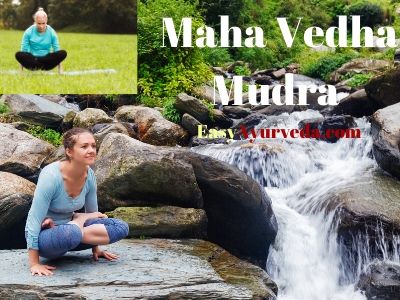Maha Vedha Mudra – Meaning, Method Of Doing, Benefits
By Dr Raghuram Y.S. MD (Ay) & Dr Manasa, B.A.M.S
Maha Vedha Mudra translated to the great penetrating gesture, is an advanced level gesture which can be performed by only those yogis who are practicing it for long time.
Table of Contents
Meaning
Maha = great
Vedha = piercing / penetrating
Mudra = gesture / seal / pose / mark
This gesture activates the root chakra and also the Kundalini energy located in it. This is also said to be an Adhara Mudra i.e. perineum gesture practice.
Read – Mudra – The Science Of Gesture: Benefits, Types, How To Practice

Procedure
- Sit comfortably on a yoga mat. You can start with padmasana i.e. lotus pose.
- Breathe in slowly and deeply so as to relax your body.
- Close your eyes. This will help you focus on the gesture.
- Place the palms of both hands on the floor beside your thighs.
- The fingers should be pointing forward. Alternatively make fists with knuckles facing down.
- Keep the arms straight and relaxed.
- Keep your spine erect.
- Inhale slowly and deeply through your nose.
- Hold your breath inside.
- Now perform Jalandara Bandha.
- Now gradually raise your body by placing all the weights on the hands and straightening your arms.
- Gently beat the butts on the ground for about 3 times. This could be made possible with bending of elbows. While doing so, keep your awareness diverted towards the root chakra.
- Your butts and back of your thighs should touch the ground simultaneously.
Read – Chakra – Kundalini: Introduction, Meaning, Types, Location, Ayurveda View
Release –
- Rest the butts on the floor.
- Release Jalandhar Bandha. Exhale slowly and deeply. This completes one complete cycle of practice.
- When the breathing returns to normal, inhale and repeat the process.
- You may repeat this cycle for 3 times if you are a beginner.
- As you advance into the process and gradually expertise over it, you can add the number of cycles. You can do 9-11 cycles in this case.
Precautions, Contraindications
Do not practice this gesture if you have
- hypertension or
- any heart related diseases
- sciatica
- weakness or inflammation of the knee joints
- infection or inflammation in pelvis and surrounding areas
Don’t practice during menstruation and pregnancy.
Read – Factors That Harm Fetus, Avoidable Food And Habits In Pregnancy
Don’t allow your tail bone to strike the hard surface of the ground. Be cautious about it. This may cause injury to the bone.
Benefits
- Activates Kundalini energy located at the base of the spine at the root chakra. It helps combine prana and apana to move through sushumna to activate kundalini.
- Awakens psychic faculties
- Helps in turning your mind inwards
- Stimulates your endocrine system, activates pineal gland, controls and balances the production of hormones
- Keeps the pituitary gland and its functions under control
- Regular practice has anti-ageing effect
- Helps in curing wrinkles of the skin
- Increases appetite
- Bestows the benefits of Jalandhara Bandha
- The lifting and dropping of the body in this gesture builds up the cushioning in the sacral area. This helps to sit down for long hours while meditating.
- Mahamudra and Mahabandha do not yield good results without practicing Mahavedha. Therefore the yogi should practice all three of them successively for optimum benefits. One who practices these three will surely conquer death.
- Good actions are done and evil actions are automatically discouraged.
Effect on Chakras
This gesture mainly balances the muladhara chakra i.e. root chakra. It activates the kundalini energy therein.
Read – Dhatu – 7 Body Tissues As Explained In Ayurveda
Impact on doshas and tissues
By seeing the benefits of this gesture it can be inferred that it has a balancing impact on prana vayu and apana vayu and also their axis. It also balances the prana vayu – sadhaka pitta – avalambaka axis in the brain, checks the imbalances of raja and tama qualities of the mind and thus is beneficial for mind health. It also balances the brain hormones. It is good for all tissues but is exclusively good for rasa tissue.
Click to Consult Dr Raghuram Y.S. MD (Ayu) – Skype










One comment
Nitesh Khonde
Mudras are done by ancients time which is really beneficial for our health. Your blog is really doing well from which many of us can get health benefit.